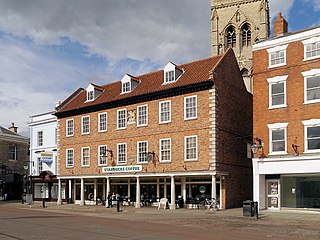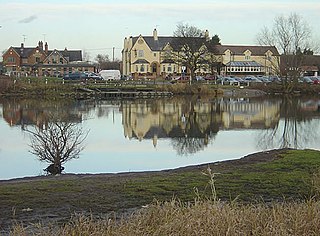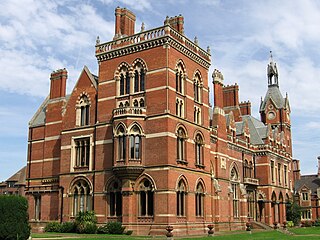Oliver Sutton, Bishop of Lincoln from 1280 to 1299, was from the Sutton branch of the influential Lexington family on his mother's side. He was an unusually popular bishop and officiated at the funeral of Queen Eleanor in 1290. [8]
In Far Holme Lane can be found the Old Manse and the Old Chapel - these are the remnants of the small Particular Baptist church that existed here from 1822 to the 1900s. Although some Baptist historical writing suggests that the church was founded by Alexander Jamieson with the support of the wealthy Haldane brothers of Glasgow in the period 1800–1810, there is fairly convincing evidence that it was actually 'planted' by the Collingham Baptist congregation under William Nichols. George Pope may then have become its own minister - before himself moving to Collingham. Nichols was active in the village as early as 1809. Nichols wrote an obituary of a Sutton woman in the Baptist Magazine, volume 7, 1815, which provides one of the few accounts of the life of an ordinary Sutton-on-Trent woman that we have and so is worth repeating verbatim:
JANE RICHARDSON of Sutton on Trent, near Newark, who died January 23d, 1815, aged 81 years.
On our first going to Sutton, to preach the gospel, in 1809, this old disciple was made known to us. She then expressed to me the joy and pleasure it afforded her that the gospel was brought to that wicked village —" Here I have been, like a poor speckled bird, ever since I came to it, shut out from hearing the word, which I had enjoyed in my former situation, though I had then to walk five miles on the Lord's day, and often to wade to the knees in water, but I found the word sweet to my soul, which made amends for all my trouble of getting to the house of God. O! how I have lamented the loss of those means of grace ; but I hope that Lord has not left me; and now I pray that the preaching here may be blessed to my soul, and to my neighbours, who are dead in trespasses and sins, though they know it not."
When she understood we were of the Baptist denomination, she said, "I wish they were not, for I cannot see any necessity for our being dipped, besides, if it should be the right way l am too old now. She, however, began to read the New Testament with a spirit of inquiry, and while thus engaged, she found that Jesus was baptized- That he ordered his apostles to baptize as well as preach, and that this was to be extended to by all succeeding ministers, to the end of the world. One morning, after having been reading thus, she hastened to a neighbour, with her bible in her hand, to whom she said, " Well, neighbour, I believe Baptism is right, and if it please the Lord to give me strength, I will be baptized, old as I am." Her neighbour replied —" I don't believe it, I won't believe it, nor would I have you trouble your head about it —I don't like this baptism, for my part."—' Well, neighbour, but if Jesus Christ has commanded us to follow his example, saying, thus it becometh us to fulfil all righteousness," as you see it is here in the third chapter of Matthew, and the fifteenth verse —I think we ought. I shall, therefore, offer myself for baptism, if it please the Lord to spare me." This she did in the spirit of love to her Lord and Saviour without delay—On the 7th of April, 1811, the day appointed for her to relate her Christian experience to the church, at Collingham, previous to her being baptized, she rose early in the morning to walk thither, a distance of three miles. Her aged husband offered to go with her, but she replied, you need not do that, the Lord will go with me ; accordingly she tied a small bundle of cloths to her side, took her two sticks, and arrived by eight o'clock.
No sooner had she taken some refreshment, than she began to sing a hymn. I said, "well my friend you appear to have got here better than one could expect at your time of life. "O yes," she replied, " and my heart is full of joy; and I believe the Lord will carry me through the duties before me this day." She gave in her experience before the church with great composure, and went through the ordinance of baptism with great courage. On leaving us, to return in the evening, she said, at parting, "blessed be my God and Saviour for this day." Thus, like the eunuch, she went on her way rejoicing. She afterwards met with persecution from the ungodly around her, but in the general, she was carried above it, rejoicing that she was accounted worthy to Suffer shame for Christ's sake. Her attendance on the means of grace was uniform and serious ; she appeared to find the word of God and eat it, and it was the joy and rejoicing of her soul.
When certain professors tried to draw her aside, and poison her mind, she would either turn a deaf ear, or reply, "O let us be thankful for the gospel which God has sent among an unworthy people." And in reference to those attempts, she said to a friend a few days before she died, "Blessed be God, they never moved me at all."
When confined by her last illness, being visited by a Christian friend, who asked her whether he should pray for her recovery, she replied, "Pray that the Lord's will may be done concerning me, I desire not anything contrary to his will, life or death." And thus she departed, committing herself into the hands of Christ, knowing in whom she had believed, and being fully persuaded he was able to keep that she had committed to him against that day.
A Board School was leased from the Church School Trustees and endowed in 1816, and Sutton Mill a stone tower windmill built in 1825, (It is now a residence) and by 1900 the area was known for its basket making. A feastival is still held on the first of November each year. [13] [14]

























